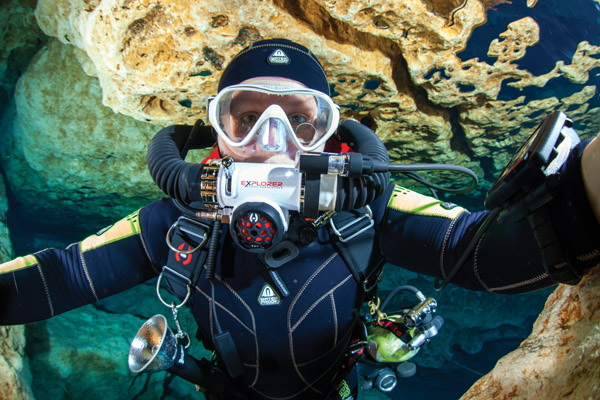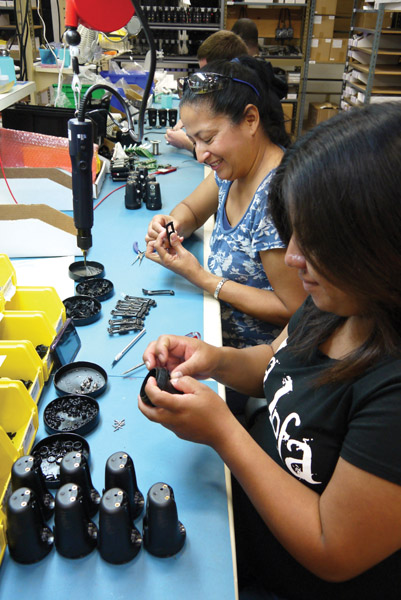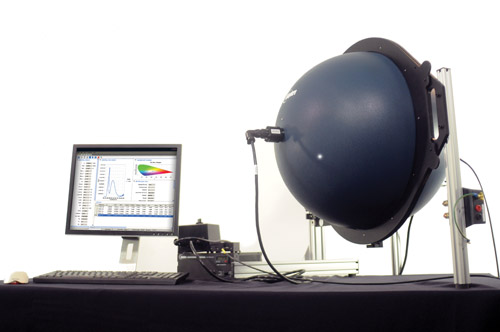How to Choose a Video Light
By Jill Heinerth

I have a confession: I have a bit of a light fetish. I can’t seem to stop buying new lights. Headlamps, solar rechargeable, hand-cranked lanterns, cinema lighting, LED key fobs and endless cave diving and video lights. I have them all. And this doesn’t include the numerous bicycle lights my husband Robert and I have collected, because, well, I can pin that one on him. Whew, I’m glad to finally share this and get it off my shoulders!
The fact is lighting has improved exponentially since I began diving. In my early cave diving career we lugged enormous sealed lead acid battery packs that powered feeble incandescent bulbs barely able to last a single dive. If we had to carry those lights today, they would tip the scales at the airport and get rejected as hazardous cargo.
I had intended to review several video lights this month, but soon discovered that it was painfully difficult to navigate the shopping experience. Specifications are hard to interpret and even more challenging to compare from brand to brand. Worse still, claimed specifications rarely match actual performance in the field. Video lights can be a big investment, so it is worth examining some of the features and issues you should consider when shopping. I broke my research into several categories, including: lumens, duration, beam quality and coverage, burn curve, weight/size/buoyancy, depth rating, build quality, purpose, company reputation and environmental impact.

Lumens
The lumen is the unit that scientists use to examine the luminous flux from a light source. In essence, lumens, or lumina, accurately describe the brightness of a light. The National Institute of Standards and Technology measure lumen output using a device called an integration sphere. They use photometers to count light particles inside the sphere.
In 2009, the American National Standards Institute (ANSI) approved a standard for flashlight performance. The resulting specification called ANSI/NEMA FL-1 is designed to help consumers make fair comparisons of lights and to eliminate exaggerated light performance by quoting odd features such as “emitter lumens” or “out-the-front lumens”. Tests can be performed by the manufacturer or an independent lab; however, the necessary equipment and calibration makes this an expensive undertaking. My research to date indicates that manufacturer Light and Motion tests their lights to this specification and shares the results with consumers on their website at www.LightandMotion.com.
Duration and Burn Curve
When lumens are tested, the actual runtime should also be reported. Burn time is determined when the light output drops to 10 percent of its original value using the batteries included with the flashlight. When viewing the test results of competitive light brands on Light and Motion’s website it appears that numerous manufacturers are over-reporting the intensity and burn time. Some models actually performed at 50 percent of the claimed specification. None of the lights listed in the comparison charts performed better than their advertised quality when tested to the FL-1 standard! It is also interesting to view the burn curves on the graphs to determine whether a light maintains brightness over the duration or whether it quickly lowers intensity to lengthen burn time. As a videographer, I want a light with a consistently bright beam.
Beam Quality and Coverage
Early underwater video lights utilized wide dimpled metal reflectors to spread the beam of light. Some employed translucent diffusers to improve the dispersion of the beam. Newer, low profile reflector solutions and LED angles can create a soft and even light beam with a wide range of coverage. Look for a light that does not have hot spots and that evenly covers a wide area. A lighting manufacturer usually specifies whether a light is a ‘spot’ or a ‘flood’ and should indicate how many degrees of coverage the device will deliver.
Purpose/Multipurpose
The best video lights are expensive, yes, but they may offer the benefit of multi-function capability. Some lights can be dimmed and used as primary lights for technical diving. Some offer focusable lenses that narrow a beam to a more suitable angle of coverage for cave and wreck diving.
Weight, Sizeand Buoyancy
I have often struggled with American airport security, the TSA, when trying to fly with large battery packs and cinema lights. There is a limit to the size of lithium batteries that are allowed on a commercial aircraft. Smaller, lighter units can be easily flown without challenge from airport security. Buoyancy characteristics are also important. Lights are often affixed to long extension arms. Negatively buoyant light heads can be problematic and tiring to swim for any length of time.

Company Reputation
A video light is an investment and it may need service in the future. Buying lights that are made as close to home as possible from a reputable company makes sense. Customer service, reputation, innovation and warranty are all issues to explore. A company’s customer service reputation may be as important as the units they sell. Ask around, and get opinions from other divers.
Environmental Impact
There are many ways that a manufacturer can be environmentally responsible. Using recycled materials, rechargeable batteries and a local workforce will all reduce the environmental impact. If the light has rechargeable batteries it may save significant money over the life of the product. Consider the operating cost to your wallet, and the environment, in your purchase decision.
Purchasing quality video lights takes some serious research. But as you are gliding effortlessly over a colorful reef while enjoying the vibrant colors of the underwater world, you will know it was an investment worth making.







